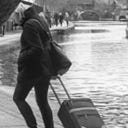Navigating Nairobi
Caroline Knowles
Looking out on Mathare; an informal, low-income settlement in Nairobi, home to between 200,000 and 500,000 people the city authorities have been unable to count, I see a dense tangle of shelters, rigged together from wood and rusting corrugated iron stretching into the distance. Women are washing clothes; children play in the dust. Water is only available at weekends, at high prices from private operatives. There is no power and the main sources of fuel: wood, charcoal and kerosine, often cause fires. Cholera outbreaks and police raids are regular features of life here. Without formal housing or stable employment, those who live here, like those who live in other informal settlements, must duck and dive to make ends meet. Sporadic work, spotting opportunities on the wing, securing wood and water for cooking and washing, running errands: crafting a life in hostile circumstances takes resilience, ingenuity, nimbleness, and access to all manner of mobilities.
Navigating a city the size of Nairobi (population approximately 5 million), especially for those whose livelihoods depend on their ability to move about and weave together elements of daily survival, is a complicated and costly matter, especially when transport infrastructures don’t take their needs into account. Mobility really matters here. Yet the options are limited. When fragile incomes don’t stretch to motorbike taxis and minibuses that ply set routes through the city; and there are big gaps in rigged together city transport networks, walking is often the only alternative
The community worker at the Mathare Social Justice Centre, which fights for food security, disability justice and ecological justice and who also supports the mothers of boys who are victims of extrajudicial killings, calls the meeting to order to discuss this particular difficulty — getting around the city. Residents have been gathered together to take part in an experimental piece of research, run from the UK’s University of York and Nairobi’s Stockholm Environment Centre, led by Steve Cinderby, and funded by the British Academy GCRF Urban Infrastructures of Well-Being Programme[i]. The researchers want to do something they call a ‘transect walk’ with local residents, to identify the obstacles and difficulties they face in moving around their city, hopefully generating data that can be used to lobby city authorities for improvements.
We set off along one of the most well-trodden routes from inside the settlement to the main road transport routes. The beginning of the route is narrow and winding. Alongside simple shacks, street vendors and cart pushers jostle with pedestrians and motorbikes for space on untarred roads full of pitfalls and potholes, raw sewage, and uncollected garbage. Evangelical churches peddle hope and collect money, political slogans and peeling posters announce hopeful candidates in the upcoming general election. As we approach the main road the space for walking narrows and gradually widens again, but walkers must deal with heavy motor traffic alongside the Air Force Barracks. The sides of the road — there is no pathway — are scattered with garbage among which plastics predominate. This is the main transport route, plied by the ubiquitous minibuses that count as public transport, although they are privately owned.
Together, researchers and residents have provided something the city authorities don’t know about — a detailed picture of the mobilities, concerns and difficulties in moving around Nairobi for low-income residents, and especially women and the disabled whose difficulties are compounded by their particular vulnerabilities. Together, they have identified the many gaps in the city’s ad hoc transport system, which doesn’t adequately reach this and similar informal settlements. They documented the hazards faced by wheelchair users, and the stress and anxiety generated when pedestrians must share space with traders, motorbike taxis and other motorised vehicles. Researchers discovered that people are not so aware of atmospheric pollution, but it nonetheless impacts their health and wellbeing. Through their stories and maps and participation in co-design, residents have fed their views into potential solutions for providing better separation of traffic and pedestrians, extending the transport system to dense settlements like Mathare, and the need for traffic calming measures and safe crossing points especially near schools. A parallel investigation in Likoni, Mombasa is underway. The methods of research and the data they generate will be useful in other African urban settings, where low-income populations face similar difficulties.
[i] Co-Is are Romanus Opiyo and Casilde Muhoza (SEI Nairobi), Karen Lucas (University of Leeds), and Nancy Abira (TIMCOM Associates). It combines expertise in Transport Engineering, Geography and Sociology with strong partnerships on the ground in Nairobi with the Mathare Social Justice Centre and Constant Cap, a senior programme manager and urban planner at Code for Africa.
